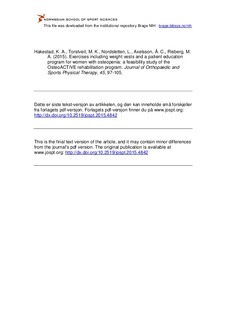| dc.contributor.author | Hakestad, Kari Anne | |
| dc.contributor.author | Torstveit, Monica Klungland | |
| dc.contributor.author | Nordsletten, Lars | |
| dc.contributor.author | Axelsson, Åsa Christina | |
| dc.contributor.author | Risberg, May Arna | |
| dc.date.accessioned | 2016-02-02T10:38:03Z | |
| dc.date.available | 2016-02-02T10:38:03Z | |
| dc.date.issued | 2015-01-10 | |
| dc.identifier.citation | Journal of Orthopaedic & Sports Physical Therapy, 2015, 45, 97–105 | nb_NO |
| dc.identifier.uri | http://hdl.handle.net/11250/2375667 | |
| dc.description | I Brage finner du siste tekst-versjon av artikkelen, og den kan inneholde ubetydelige forskjeller fra forlagets pdf-versjon. Forlagets pdf-versjon finner du på http://www.jospt.org/doi/abs/10.2519/jospt.2015.4842 / In Brage you'll find the final text version of the article, and it may contain insignificant differences from the journal's pdf version. The definitive version is available athttp://www.jospt.org/doi/abs/10.2519/jospt.2015.4842 | nb_NO |
| dc.description.abstract | Study Design:
Prospective case series with 1-year follow-up.
Objectives:
The primary aim was to describe the OsteoACTIVE rehabilitation program and evaluate its feasibility in terms of progression, adherence, and adverse events in patients with low bone mineral density (BMD) and a healed forearm fracture. The secondary aim was to assess changes in measures of function and quality of life.
Background:
Previous studies have shown benefits of weight-bearing activities, resistance exercises, and balance and coordination training for women with low BMD and older adults. However, no studies, to our knowledge, have described or examined a rehabilitation program combining the use of weight vests and patient education in patients with low BMD.
Methods:
Forty-two postmenopausal women with osteopenia and a healed forearm fracture attended the OsteoACTIVE program for 6 months (3 sessions of 60 minutes per week). Feasibility was assessed by documenting training progression (load and exercises), program adherence (aiming for greater than 80%), and adverse events (joint pain, muscle soreness, and falls). Secondary measures included quadriceps strength, BMD, dynamic balance, walking ability, and self-report functional outcome measures. All outcome measures were recorded preintervention (baseline), postintervention, and at 1-year follow-up.
Results:
Thirty-five women (83%) completed the 6-month program and 31 women (74%) attended all the follow-up measurement sessions. All participants progressed during the rehabilitation program for both load and type of exercises. Furthermore, 87% of the participants met the a priori goal of 80% adherence, and no participants reported adverse events. Improvements in quadriceps strength and BMD of the femoral trochanter were noted at the end of the 6-month training period (P<.05). At 1-year follow-up, there were significant improvements in quadriceps strength and dynamic balance compared to baseline (P<.05).
Conclusion:
The OsteoACTIVE rehabilitation program was feasible and achieved progression of training level, had high adherence, and had no adverse events. Positive improvements were established in lower extremity function and femoral trochanter BMD. | nb_NO |
| dc.language.iso | eng | nb_NO |
| dc.publisher | Williams & Wilkins Co. | nb_NO |
| dc.subject | adverse events | nb_NO |
| dc.subject | bone mineral density | nb_NO |
| dc.subject | exercise | nb_NO |
| dc.subject | osteoporosis | nb_NO |
| dc.title | Exercises including weight vests and a patient education program for women with osteopenia: a feasibility study of the OsteoACTIVE rehabilitation program | nb_NO |
| dc.type | Journal article | nb_NO |
| dc.type | Peer reviewed | nb_NO |
| dc.subject.nsi | VDP::Social science: 200 | nb_NO |
| dc.subject.nsi | VDP::Social science: 200::Social science in sports: 330 | nb_NO |
| dc.subject.nsi | VDP::Social science: 200::Social science in sports: 330::Other subjects within physical education: 339 | nb_NO |
| dc.source.journal | Journal of Orthopaedic and Sports Physical Therapy | nb_NO |
| dc.description.localcode | Seksjon for idrettsmedisinske fag / Department of Sport Medicine | nb_NO |
